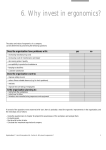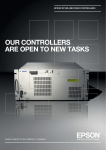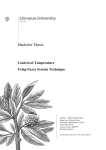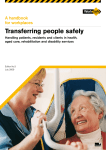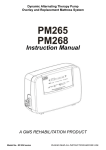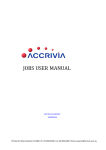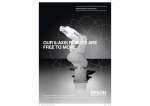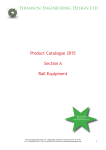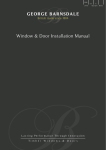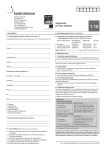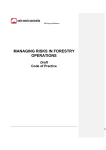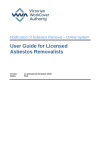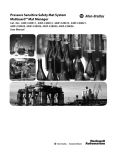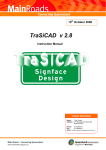Download a guide to safety in the wood products
Transcript
A GUIDE TO SAFETY IN THE WOOD PRODUCTS MANUFACTURING INDUSTRY 1ST EDITION MARCH 2007 MANUFACTURING * NEW Dangerous Goods (Storage and Handling) Regulations 2012 On 1 December 2012, the Dangerous Goods (Storage and Handling) Regulations 2012 (DG (S&H) Regulations 2012) replaced the Dangerous Goods (Storage and Handling) Interim Regulations 2011 (Interim Regulations) which expired on this date. The DG (S&H) Regulations 2012 have retained most of the legal requirements contained in the Interim Regulations. There are only a small number of changes. This document has not yet been updated to reflect the changes introduced by the DG (S&H) Regulations 2012. More information on the key changes introduced by these new regulations can be found in the guidance titled Information about: Key changes to dangerous goods storage and handling requirements available at worksafe.vic.gov.au/dgkeychanges and More information about: Incident reporting available at worksafe.vic.gov.au/incidentreporting CONTENTS INTRODUCTION . . . . . . . . . . . . . . . . . . . . . . . . . . . . . . . . . . . 2 4. ENVIRONMENT . . . . . . . . . . . . . . . . . . . . . . . . . . . . . . . 35 The legal framework. . . . . . . . . . . . . . . . . . . . . . . . . . 2 Noise . . . . . . . . . . . . . . . . . . . . . . . . . . . . . . . . . . . . . 36 Hazard Identification, Risk Assessment Wood dust . . . . . . . . . . . . . . . . . . . . . . . . . . . . . . . . 37 and Risk Control . . . . . . . . . . . . . . . . . . . . . . . . . . . . . 2 Dangerous goods and hazardous substances. . . . . 37 Consultation . . . . . . . . . . . . . . . . . . . . . . . . . . . . . . . . 3 Lighting . . . . . . . . . . . . . . . . . . . . . . . . . . . . . . . . . . . 38 ‘Reasonably practicable’ control measures . . . . . . . . 4 Housekeeping . . . . . . . . . . . . . . . . . . . . . . . . . . . . . . 39 Information for employers . . . . . . . . . . . . . . . . . . . . . 4 Plant layout . . . . . . . . . . . . . . . . . . . . . . . . . . . . . . . . 39 1. PLANT . . . . . . . . . . . . . . . . . . . . . . . . . . . . . . . . . . . . . . . . . 6 Protective clothing and equipment (PPE) . . . . . . . . 39 Guarding . . . . . . . . . . . . . . . . . . . . . . . . . . . . . . . . . . . 8 OTHER USEFUL GUIDANCE MATERIAL . . . . . . . . . . 41 Using hand tools . . . . . . . . . . . . . . . . . . . . . . . . . . . . 11 ACKNOWLEDGEMENTS . . . . . . . . . . . . . . . . . . . . . . . 42 2. MANUAL HANDLING AT THE WORKPLACE . . . . . 15 Manual Handling and Musculoskeletal Disorders . . 16 Removal of raw material from storage . . . . . . . . . . 18 Transport of materials on the shop floor . . . . . . . . . 20 Handling trolleys . . . . . . . . . . . . . . . . . . . . . . . . . . . . 23 Manufacturing product at workstations. . . . . . . . . . 24 Unloading finished products from the production line . . . . . . . . . . . . . . . . . . . . . . . . . . 26 Loading finished product . . . . . . . . . . . . . . . . . . . . . 28 Unloading product and on-site installation. . . . . . . . 30 3. MAINTENANCE AND CLEANING . . . . . . . . . . . . . . . 34 WorkSafe Victoria is a division of the Victorian WorkCover Authority. The information presented in A Guide to Safety in the Wood Products Manufacturing Industry is intended for general use only. It should not be viewed as a definitive guide to the law, and should be read in conjunction with the Occupational Health and Safety Act 2004. Whilst every effort has been made to ensure the accuracy and completeness of the guide, advice contained herein may not apply in every circumstance. Accordingly, the Victorian WorkCover Authority (VWA) cannot be held responsible, and extends no warranties as to: • the suitability of the information for any particular purpose; • actions taken by third parties as a result of information contained in A Guide to Safety in the Wood Products Manufacturing Industry. This publication is protected by copyright. The Victorian WorkCover Authority (VWA) encourages the free transfer, copying and printing of this publication if such activities support the purposes and intent for which the publication was developed. WORKSAFE VICTORIA / A GUIDE TO SAFETY IN THE WOOD PRODUCTS MANUFACTURING INDUSTRY 1 INTRODUCTION This guide demonstrates WorkSafe Victoria’s expectations on how to best eliminate or reduce the risk of injuries in the wood products manufacturing industry. Many risk controls detailed in this guide have already been implemented in the industry in Victoria. THE LEGAL FRAMEWORK There is a legislative framework around controlling risk in consultation with Health and Safety Representatives and employees within the workplace and this guide shows how to comply with the Occupational Health and Safety Act 2004. HAZARD IDENTIFICATION, RISK ASSESSMENT AND RISK CONTROL Hazard identification This guide identifies tasks in the wood products manufacturing industry that are hazardous and can result in injuries. However; it is not a comprehensive list of all hazardous tasks in the industry. Risk assessment Further, this guide cannot replace the requirement for risk assessment and risk control as the risk of an injury will vary depending on the circumstances in your workplace. To ensure a reduction in injuries, employers should review risks and develop and implement a plan for controls – this should be done in consultation with employees. 2 WORKSAFE VICTORIA / A GUIDE TO SAFETY IN THE WOOD PRODUCTS MANUFACTURING INDUSTRY INTRODUCTION Risk control Risk controls are shown in this guide. It is the duty of an employer to carry out risk control under the Consolidated Occupational Health and Safety Regulation 2007 that come into effect on 1 July 2007 replacing the current regulations. These require the following actions to be taken: 1. eliminate the risk 2. if it is not practicable to eliminate the risk, reduce the risk so far as is practicable. In either case, the risk can be controlled by any of the following ways: a. altering the workplace or environmental conditions b. altering the systems of work c. changing the objects d. using mechanical aids. A combination of controls often gives the best solution. Consulting Health and Safety Representatives and employees, and trialling proposed solutions will determine if they are right for your workplace or if further modifications or different controls are required. It is necessary to monitor the success or otherwise of the controls implemented. Provision of information, training and instruction cannot be used as the sole or primary way of controlling the risk unless all other ways to control risk are not practicable. Where training is provided, it must be both task specific and competency based in order to be effective. Supervisors must themselves be competent in how to best use specific risk controls and must be supported in this role. There should also be appropriate supervision of safety as well as production. You should always check the legislation referred to in this material and make your own judgement about what action you may need to take to ensure you have complied with the law. Note: This guide should be used in conjunction with the Occupational Health and Safety (Manual Handling) Regulations 1999, Occupational Health and Safety (Plant) Regulations 1995 and the relevant codes of practice. On 1 July 2007 the new consolidated regulations will come into effect replacing the current regulations. CONSULTATION All employers are required to consult their employees, so far as reasonably practicable, on matters that may directly affect employees’ health, safety or welfare. This includes consultation with independent contractors and any employees of that independent contractor. Where there are elected Health and Safety Representatives the employer must consult them on hazard identification, risk assessment, and risk control as well as any proposed changes in the workplace, plant, substances or work processes that could impact on workers’ health, safety or welfare. It is important that HSR’s have access to training in their roles. HSR’s and deputy HSR’s have a legal entitlement to attend an initial five day OHS representatives course and an annual refresher course with the training provider of their choice. The duty to consult recognises that employee input and participation improves decision-making about health and safety matters. Consultation between employers and employees is an essential part of effectively managing health and safety at work. It is a legal requirement and is a valuable means of improving health and safety outcomes. Through consultation, employers can become more aware of hazards and OHS issues experienced by employees – they can also provide suggestions about how to solve OHS problems. Employee participation allows them to contribute to determining how the work can be done safely. It is important to remember that consultation is a form of negotiation and not simply a ‘notification of change’ process. This process allows for issues to be discussed and the sharing of ideas across all levels of the organisation in an attempt to find the most practicable solution to identified hazards or issues on-site. WORKSAFE VICTORIA / A GUIDE TO SAFETY IN THE WOOD PRODUCTS MANUFACTURING INDUSTRY 3 INTRODUCTION For more information on the duty to consult, please refer to the following WorkSafe publications: • • • • Talking Safety Together and Consultation – A User’s Guide Information for Employees on Health and Safety Employee Representation Guide, and Information for Health and Safety Representatives ‘REASONABLY PRACTICABLE’ CONTROL MEASURES The Occupational Health and Safety Act 2004 explains what must be taken into account when deciding if something is ‘reasonably practicable’. In general terms, the factors to be considered are: • the likelihood of the hazard or risk concerned eventuating • the degree of harm that would result if the hazard or risk eventuated • what you know, or ought reasonably to know, about the hazard or risk and any ways of eliminating or reducing the hazard or risk • the availability and suitability of ways to eliminate or reduce the hazard or risk • the cost of eliminating or reducing the hazard or risk This guide shares information on what you know, or ought reasonably to know, and therefore what you should reasonably do. It is expected that employers, HSR’s, employees and WorkSafe inspectors will use this information to form an opinion about suitable health and safety risk controls, under the test of ‘reasonable practicability’. INFORMATION FOR EMPLOYERS The use of contractors, labour hire employees and trainees is not uncommon in the wood products manufacturing industry. These workers are the responsibility of the host employer if they are engaged to work on site. Host organisations are deemed to be employers of contractors – and their direct employees – in relation to matters over which they have control. Therefore, both labour hire companies and host organisations have the duty to ensure labour hire workers are provided with safe workplaces. Before entering into a labour hire worker contract, both the labour hire company and host organisation should ensure that: • training, skills and experience of workers are verified and match the needs of the task • identification, assessment and control of all the risks associated with the task must be completed before the work commences • the worker is inducted into systems of work • the worker is adequately supervised • the worker has the opportunity to consult with both the on-hire employer and host organisation • the worker knows what to do when health and safety issues arise in the host’s workplace. There is specific guidance for both host employers and labour hire agencies available in hardcopy and on the WorkSafe website. Management training is available for employers on the principles of occupational health and safety • host employer guidance information: Managing the safety of labour hire workers • labour hire agencies: Managing the safety of on-hired workers For further information visit www.worksafe.vic.gov.au 4 WORKSAFE VICTORIA / A GUIDE TO SAFETY IN THE WOOD PRODUCTS MANUFACTURING INDUSTRY INTRODUCTION HOW TO USE THIS GUIDE This guide provides examples of tasks undertaken in wood products manufacturing, but it does not cover all tasks. Therefore, it is important to review your own operations and apply some of the solutions or principles shown. The red, amber and green or ‘traffic light’ format used throughout this guide can help you identify high risk activities and assess your workplace, allowing you to implement safer work practices. The rationale is simple: to reduce injury rates and compensation claims, high risk situations must be addressed. If you are able to tick any of the boxes in the red which represent high risk activities then you should read further about the reduced risk and low risk controls shown. If high risk practices are followed in your workplace, you should determine if you can implement the solutions in the green column. If this isn’t practicable, put in place the comparable practice in the amber column as a reduced risk solution. In the amber and green columns, the solutions listed first are preferred and will generally be more effective than solutions towards the bottom of the column. Solutions in the amber and green sections in this guide provide some different options. This is because the tasks, and hence the risk, will vary according to the specifics at your workplace. HIGH RISK The practices in the red boxes or column should not be used in workplaces; an employer who allows these practices to be used is likely to be in breach of OHS legislation INTERIM WORK PRACTICE (MEDIUM RISK) PREFERRED SOLUTION (LOW RISK) The solutions in the amber column are less effective in reducing risk compared to those in the green column, and would be regularly reviewed with the aim to move towards higher order solutions (green) The solutions in the green column are the most effective at reducing risk and should be regarded as the target for all workplaces Red, high risk, column Solutions should continue to be reviewed as higher order controls become more practicable Are any solutions from the green column reasonably practicable for the workplace? (Undertake practicability test) YES Implement a solution from the green, preferred solution, column NO Implement solutions from the amber, reduced risk, column Note: If you are able to demonstrate an appropriate risk assessment process has been undertaken and you are able to verify that the ‘reasonably practicable’ test has been applied to the controls you implement, then control measures in the amber range may be practicable in some circumstances. WORKSAFE VICTORIA / A GUIDE TO SAFETY IN THE WOOD PRODUCTS MANUFACTURING INDUSTRY 5 1 PLANT GUARDING USING HAND TOOLS 6 WORKSAFE VICTORIA / A GUIDE TO SAFETY IN THE WOOD PRODUCTS MANUFACTURING INDUSTRY PLANT PLANT IN WOOD PRODUCTS MANUFACTURING What is plant? Plant can be defined as an apparatus, machine, appliance, equipment or tool used to enhance the capacity of employees to perform tasks. Plant can be a simple lever, a tool or a complex machine. A person operating woodworking plant is often applying a cutting blade at high speed to timber. Some of the processes included in wood product manufacturing include cutting, routing, thicknessing, shaping, tenoning, etc. Manufacturers are often making products to order rather than high volume production. This requires plant to be frequently set-up for different product runs. There is also a tendency for ‘one-off’ cuts or shapes to be required in normal operation. For these reasons alone, it is paramount that plant be operated in a safe manner. In many cases, in order to machine timber it is necessary to have an exposed blade to the timber. Employers must ensure, so far as is reasonably practicable, that all plant is guarded to prevent an operator coming into contact with exposed blades or trapping spaces. Employers must ensure introducing risk controls to reduce the risk of injuries does not introduce other hazards or risks into a system of work. For example; • the introduction of a forklift requires the implementation of a traffic management plan to segregate pedestrians from forklifts • where mechanical aids or other load shifting equipment is used, such as powered pallet jacks, ensure employees are trained and competent in its use • when transferring cabinet carcases using lifting gear, ensure loads are carried within the manufacturer’s safe working load (SWL) and implement a program to monitor damage to shackles, slings etc • changes to equipment will require a plant risk assessment be conducted to ensure employees are not injured by newly introduced hazards such as trapping points or in-running nip points and that controls are put in place if risk is present. WORKSAFE VICTORIA / A GUIDE TO SAFETY IN THE WOOD PRODUCTS MANUFACTURING INDUSTRY 7 PLANT Training and supervision Employees who operate, maintain or are required to work in close proximity of plant must be trained and supervised in the operation of that plant. Complacency has been identified as one of the factors leading to many injuries when operating new plant. The inexperience of employees is a potential hazard and employers should ensure new or inexperienced employees are not left to work alone on hazardous plant. Other risk control solutions that can be used include: • • • • ensuring the right machine is used for the right purpose controlling production output in the workplace to ensure safety is still a priority a grading system related to training for operators and maintenance consultation between management and employees about guarding and machine operating procedures. Push pads and push sticks These tools are used as aides to assist operators when using wood working plant. For instance, a push pad is used to better isolate the operator’s hands from the cutting blade on a buzzer. Push sticks are often used to push timber through a rip saw. When using these mechanical aids the following administrative controls should be followed: Push sticks should never be used to: • remove off cuts from a running machine • heat up a blade by applying a friction force using the stick Kick back A common problem associated with the manufacture of timber products is the ‘kick back’ associated with rotating plant and machinery. This poses a risk to the operator when the timber being sawn or machined binds to the blade and ‘kicks back’ towards them. In these instances the guarding or riving knives may have been removed. Other situations that can lead to issues with ‘kick back’ include knots in the timber or using the wrong tool (either too powerful or not powerful enough) for the task, or a saw blade that is blunt or worn. GUARDING There are many types of guarding systems available to guard dangerous parts of machinery to prevent bodily access. If guarding is to be used as a control measure, the employer is required to ensure that any guard designed for the plant will, so far as is practicable, prevent access to the danger point or area of the plant. The guarding that is to be installed onto plant should be designed and installed by a suitably qualified and competent person. There may be instances where the guarding is to be designed and installed by an electrical contractor or someone other than the manufacturer or supplier. It is important to ensure whoever designs and installs guarding is familiar with the current Australian Standard AS4024 – 2006, Safety of Machinery, Part 1201: General Principles – Basic terminology and methodology and the current Australian Standard that relates to the equipment being guarded. The plant guarding hierarchy is as follows: 1. 2. 3. 4. 8 Permanently fixed physical barrier Interlocked physical barrier Physical barrier (fixed guard) Presence sensing system WORKSAFE VICTORIA / A GUIDE TO SAFETY IN THE WOOD PRODUCTS MANUFACTURING INDUSTRY PLANT Permanently fixed physical barrier Permanently fixed physical barriers are normally used where there is no requirement for access during operation, maintenance or cleaning of the plant. The underside of the spindle moulder is a permanently fixed guard. The housing of the machine prevents access to the motor, drive shaft or other dangerous parts. Interlocked physical barrier An interlock guard is one that is moveable or has a moveable part. The movement of the guard interacts with the dangerous parts of the plant or the control system of the plant to prevent motion of the dangerous parts while the guard is open. The interlocking system must be designed to fail to safety so it can not be defeated. The run-down time needs to be taken into account so that access is only available when sufficient time has lapsed for the motion of the danger parts has ceased. The covering doors on the saw are interlocked so that when the doors are opened, the systems shut down power and air to the saw. WORKSAFE VICTORIA / A GUIDE TO SAFETY IN THE WOOD PRODUCTS MANUFACTURING INDUSTRY 9 PLANT Physical barrier (fixed guard) A fixed guard (with no moving parts) that prevents access to the dangerous part of the machinery and provides protection while the guard is in its intended position is needed. The physical barrier can only be altered or removed by the use of a tool. A hinged door acts as a physical barrier preventing access to the drive wheel of a bandsaw. The door is bolted shut with non-conventional head bolts that can only be removed using a special tool. Where better vision of the cutting blade is required, use polycarbonate guards (e.g. panel saw). Presence sensing system These guards are usually an unseen barrier created by photoelectric or similar devices capable of electronically detecting intrusion into the hazardous area of a machine. The presence-sensing system then shuts off power to the plant and may, depending on the plant, brake the existing motion. These systems are designed with a high level of reliability and are designed to ‘fail to safe’ when the system is activated. Automatic routing machine with a light curtain detection system to prevent access to the machine. 10 WORKSAFE VICTORIA / A GUIDE TO SAFETY IN THE WOOD PRODUCTS MANUFACTURING INDUSTRY PLANT USING HAND TOOLS The definition of ‘hand tools’ used in this document is ‘a tool used with a person’s hands’. It includes: • tools that are designed for force to be applied by the person, including screwdrivers, hammers, chisels, hacksaws, etc, and • tools where the force is applied by a power source but needs a person to hold the tool such as portable electric or battery drills, sanders or saws, pneumatic impulse tools, spray guns or nail guns, etc. The Musculoskeletal disorders risks from hand tool usage mainly result from: • • • • Tool design – weight, shape, fit to user, vibration, recoil, shock loading Workstation design – size, shape and layout Task design – frequency, duration, speed of tool usage Tool maintenance – poorly maintained tools may compromise safety and also increase the effort required to use them. Poor hand tool design and excessive use of hand tools are associated with chronic disorders of the hand, wrist and forearm such as carpal tunnel syndrome and wrist tendonitis. Major factors affecting the potential for injury include: • Muscular effort in using tools (holding, operating and guiding) because of poor handle design, or heavy, poorly balanced and/or poorly maintained tools • Static loading of arm and shoulder muscles from holding tools that can lead to fatigue when maintained for prolonged periods, and eventually to injury • Awkward wrist positions that mean a tool is held with the wrist bent up, down or sideways causing additional muscular effort in using tools • Contact stresses that result in pressure on tissues or joints, such as tools pressing into the palm at the base of the thumb where blood vessels and nerves pass through the hand. This contributes to the development of carpal tunnel syndrome • Wide grip span can cause tendon injury known as ‘trigger finger’. The risk is increased when force is exerted at the limits of the grip span. WORKSAFE VICTORIA / A GUIDE TO SAFETY IN THE WOOD PRODUCTS MANUFACTURING INDUSTRY 11 PLANT CONTROL OPTIONS - HAND TOOL SELECTION Well maintained tools matched to the person and the task, used infrequently at well designed workstations do not cause harm. It is when they do not match the person or the task or are used repeatedly and/or for long periods that hand tool and work area design become critical. The best hand tool to select is one that: • • • • • • matches the task you are doing fits the workspace available reduces the force that needs to be applied fits your hand can be used in a comfortable position is well maintained. Fit the tool to the person, not the person to the tool CHECKLIST - HAND TOOL USE Answers in a red box indicates the choice of hand tool may not be appropriate for the task being performed YES NO 1. Are tools used which bend the wrist up, down or sideways? 2. Are tools selected which are: a) able to be used in either hand? b) evenly balanced? c) designed for specific purpose? 3. Are tools of more than 1.5 kg used without aids to assist in supporting them? 4. Tool handle design. Are problems caused because they: a) need to be held firmly through not having good friction with the hand? b) are made of non-resilient material (e.g. metal, etc.)? c) dig into the palm area? d) require use of a wide grip span (scissors or pliers, etc.) which is excessive (more than 10cm) or cause discomfort? e) require a lot of force applied by the back of the fingers and thumb to open the handles of tools such as pliers, scissors or shears? 5. Tool handle dimensions: a) do they have a grip diameter suitable for most workers? b) are they long enough to pass along the whole hand/palm and allow all of the hand and fingers to stay on the grip? 6. Does the design of the trigger allow: a) use by only one hand? b) activation only by the finger tips? c) it to be locked on if activated for more than 30 seconds? 7. Is there repeated shock to the hand or wrist through tool design, such as the reaction of power tools after the torque limit is reached? 8. Can torque be resisted other than by muscle force? 12 WORKSAFE VICTORIA / A GUIDE TO SAFETY IN THE WOOD PRODUCTS MANUFACTURING INDUSTRY PLANT Using hand tools Referring to the checklist above, does your task involve the following? HIGH RISK RISK CONTROL SOLUTIONS Manual handling • Heavy tools can cause awkward postures and excessive force • Use lightweight or powered alternatives, if available • Tools should be presented at a comfortable height for the operator Quality • Cheap tools have hazards associated with them - high vibration - electrical safety (not double insulated) - fractures of cutting blades - flimsy guards - lack of operating instructions - may not meet Australian Standards - noise levels - no fail safe protection • Use fibreglass and vibration cancelling hammers, if required for manual hammering operations • Use double insulated electrical power tools and earth leakage circuit breakers for all electrical equipment • Restart and overload protection • Safety clutch • Ensure tools meet Australian standards (AS/NZ 60745.1:2003) Air tools • Can be large and awkward to operate in confined areas • Require an air line to be attached at all times • Use smaller air tools in confined areas. • Use battery/gas powered tools to reduce the need for air lines Air powered nail gun • Can be noisy • Incorrect air line connections Cordless framing nail gun • Silencers on the air tools to reduce the noise levels • Use correct connections for the tools. WORKSAFE VICTORIA / A GUIDE TO SAFETY IN THE WOOD PRODUCTS MANUFACTURING INDUSTRY 13 PLANT HIGH RISK RISK CONTROL SOLUTIONS Air tools Pull Back Release To disconnect 2. Pull Back 1. Pull Back Single Ridge 3. Release Double Ridge Double action air line connection Single action air line connection • Use well maintained air compressors • Using damaged or faulty air compressors Well maintained air compressor Damaged air compressor • Relocate air compressors outside to reduce noise • Use hose stands to keep air lines off the ground Stand with coiled air hose used to reduce clutter • Direct plumbing of air lines into workstations 14 WORKSAFE VICTORIA / A GUIDE TO SAFETY IN THE WOOD PRODUCTS MANUFACTURING INDUSTRY 2 MANUAL HANDLING MANUAL HANDLING AND MUSCULOSKELETAL DISORDERS REMOVAL OF RAW MATERIAL FROM STORAGE TRANSPORT OF MATERIALS ON THE SHOP FLOOR HANDLING TROLLEYS MANUFACTURING PRODUCT AT WORKSTATIONS UNLOADING FINISHED PRODUCTS LOADING FINISHED PRODUCT UNLOADING AND ON-SITE INSTALLATION WORKSAFE VICTORIA / A GUIDE TO SAFETY IN THE WOOD PRODUCTS MANUFACTURING INDUSTRY 15 MANUAL HANDLING MANUAL HANDLING AND MUSCULOSKELETAL DISORDERS Manual handling For the wood products manufacturing industry, manual handling covers a wide range of activities such as handling wood in and out of machinery, transport of materials within the workplace, loading finished product for delivery, delivery and on-site installation. Many of these tasks can result in musculoskeletal disorders and other types of injuries. However, not all manual handling is hazardous. In this industry, hazardous manual handling refers to manual handling with any of the following characteristics: • • • • • • repetitive or sustained application of force repetitive or sustained awkward posture repetitive or sustained movement application of high force exposure to sustained vibration unstable or unbalanced loads or loads which are difficult to grasp or hold. Musculoskeletal disorders Musculoskeletal disorders (MSD) are sometimes referred to as ‘sprains and strains’. It is a term used to describe a wide variety of injuries and diseases of the musculoskeletal system including injuries to joints, ligaments, intervertebral discs and other structures in the back and injuries to joints, ligaments, tendons, muscles and nerves in the wrists, elbows, arms, shoulders, neck, abdomen (e.g. hernia), hips, knees and legs. Some of these conditions are sometimes described as repetitive strain injury (RSI), occupational overuse syndrome (OOS), cumulative trauma disorder (CTD) and work-related musculoskeletal disorder (WRMSD). In the Occupational Health and Safety (Manual Handling) Regulations 1999 (Manual Handling Regulations), all of these conditions are referred to as musculoskeletal disorders (MSD). THE LEGAL FRAMEWORK There is a legislative framework around controlling risk and consultation in the workplace. This guide shows ways to assist with compliance with the Occupational Health and Safety (Manual Handling) Regulations 1999. Under these regulations the employer has a legal duty to: • identify tasks involving hazardous manual handling • assess the risk of developing a MSD associated with the task, and • control the risk by eliminating the risk or reducing it so far as is reasonably practicable. 16 WORKSAFE VICTORIA / A GUIDE TO SAFETY IN THE WOOD PRODUCTS MANUFACTURING INDUSTRY MANUAL HANDLING Hazard identification This guide identifies some tasks performed in the wood products industry that are hazardous and known to have resulted in MSD. This is not to be taken as the complete list of all tasks involving hazardous manual handling within this industry. Risk assessment This guide follows the risk assessment format used in the WorkSafe publication Manual Handling (Code of Practice No. 25, 2000). It helps indicate which risk factors may be in your workplace and, in particular, demonstrates those high-risk work practices which may put people at risk of developing MSD. The guide cannot replace the requirement for risk assessment and risk control, as the risk of developing MSD will vary depending on the circumstances in each workplace. To ensure a reduction in MSD, employers should review risks and develop and implement a plan for controls in consultation with employees. Risk control Risk controls are shown in the guide. Under the Manual Handling Regulations it is the duty of an employer to carry out risk controls including: 1. eliminating the risk (e.g. redesigning so as to eliminate handling), or 2. if it is not practicable to eliminate the risk, reduce the risk so far as is reasonably practicable. In either case, the risk can be controlled in any of the following ways: a. altering the workplace or environmental conditions (e.g. height adjustable work surfaces) b. altering the systems of work (e.g. regular maintenance on equipment, job rotation, etc) c. changing the objects (e.g. using hand tools that minimise hand-arm vibration) d. using mechanical aids (e.g. pallet lifters, adjustable trolleys, approved forklift attachments). RED - HIGH RISK AMBER - MEDIUM RISK GREEN - LOW RISK GENERAL PRINCIPLES • Postures, movements and forces that are known to be associated with MSD should be eliminated from the workplace where possible. • Physical changes to workplace design, layout and plant are more effective than administrative risk controls such as training. • To accommodate for different people and tasks, workstations should be quick and easy to adjust. • No employee should be required to routinely work above their shoulder height or below their knees. • Keep loads close to the body. • Avoid extreme postures when exerting high force. • Reduce hand-arm vibration from power tools by selecting the appropriate tool, isolating vibration, reducing or dampening the tool’s vibration, or reducing the time exposed to it. WORKSAFE VICTORIA / A GUIDE TO SAFETY IN THE WOOD PRODUCTS MANUFACTURING INDUSTRY 17 MANUAL HANDLING REMOVAL OF RAW MATERIAL FROM STORAGE Raw materials are taken from the storage area and moved through to the beginning of the manufacturing process. Does the work involve any of the following? HIGH RISK TICK Pushing or pulling objects that are hard to move or stop, e.g. handling timber from the top of a storage rack Exerting high force while in an awkward posture, e.g. handling heavy material from the ground Repetitive bending of the back more than 20 degrees, e.g. reaching into racking to handle timber INTERIM WORK PRACTICE (MEDIUM RISK) PREFERRED SOLUTION (LOW RISK) • Use mobile steps and height adjustable trolleys to remove timber from racks • Use appropriate storage locations • Storage should occur within the ‘best working zone’ – between shoulders and knees – wherever possible • Keep floors clean, smooth and well maintained • Use of appropriate hand trolleys • Install custom designed racking systems so material can be moved by forklift Custom designed storage racking for raw materials • Load timber on mobile trolleys in storage location Trolley used for moving lengths of timber to production line 18 WORKSAFE VICTORIA / A GUIDE TO SAFETY IN THE WOOD PRODUCTS MANUFACTURING INDUSTRY MANUAL HANDLING INTERIM WORK PRACTICE (MEDIUM RISK) PREFERRED SOLUTION (LOW RISK) Mobile storage racking for raw material • Use mechanical aids such as vacuum lifting equipment for handling heavy or large product in or out of racking, where practicable A vacuum lifter attached to a mobile jib crane • Use appropriate load shifting equipment, e.g. forklifts or walking stackers for moving timber Electric walking stacker for moving bulk raw materials WORKSAFE VICTORIA / A GUIDE TO SAFETY IN THE WOOD PRODUCTS MANUFACTURING INDUSTRY 19 MANUAL HANDLING TRANSPORT OF MATERIALS ON THE SHOP FLOOR Raw materials are moved within the workplace from the raw material storage area, through each production process, to the distribution of the finished product. Does the work involve any of the following? HIGH RISK TICK Pushing or pulling objects that are hard to move or stop, e.g. moving timber frames, glass or other products around the shop floor Exerting high force while in an awkward posture, e.g. unloading long or heavy raw materials Repetitive bending of the back more than 20 degrees, e.g. reaching and lifting product from packs or pallets INTERIM WORK PRACTICE (MEDIUM RISK) PREFERRED SOLUTION (LOW RISK) • Use A-frame trolleys to transport large and heavy raw materials and manufactured product throughout the production process • Use mechanical aids like overhead cranes and vacuum lifters to reduce the need for materials to be moved manually. A-frame trolley used to transport glass Vacuum lifter used to transfer raw timber to machine table 20 WORKSAFE VICTORIA / A GUIDE TO SAFETY IN THE WOOD PRODUCTS MANUFACTURING INDUSTRY MANUAL HANDLING INTERIM WORK PRACTICE (MEDIUM RISK) A-frame trolley used to transport window frames • Use L-frame trolleys to transport large and heavy raw materials throughout the production process PREFERRED SOLUTION (LOW RISK) Vacuum lift for glazing windows • Use hydraulic lifts/scissor tables to reduce bending Scissor lift to raise boards of MDF to the correct height for transfer to wood working machinery L-Frame trolley WORKSAFE VICTORIA / A GUIDE TO SAFETY IN THE WOOD PRODUCTS MANUFACTURING INDUSTRY 21 MANUAL HANDLING INTERIM WORK PRACTICE (MEDIUM RISK) PREFERRED SOLUTION (LOW RISK) • Ensure trolleys are designed with wide wheels which have large diameters • Use spring lifters with turntables to reduce awkward postures, forward bending and reaching when handling product Trolley used to move cut lengths of timber to designated production areas. • When using stands or trolleys, implement a system where wood product is stored in such a way that does not require the operator to lift below knee height or above shoulder height • Use conveyors to move timber from one workstation to the next in the production process Fixed roller conveyors used to transport timber between work stations 22 A spring lifter with a pallet ring in the photo above minimises reaching and forward bending for the employee • Air tables fixed to plant and machinery help to reduce the force needed to move heavier pieces Air table uses compressed air and rollers to float the item so it requires a small force to move heavy timber along it WORKSAFE VICTORIA / A GUIDE TO SAFETY IN THE WOOD PRODUCTS MANUFACTURING INDUSTRY MANUAL HANDLING HANDLING TROLLEYS POTENTIAL HAZARD SOURCE RISK CONTROL Trolley design and number • Poor trolley design results in a high centre of gravity so that pushing over uneven surfaces may tip trolley • Use lightweight or powered alternatives, if available • Trolley should be presented at a comfortable height for the operator • No handles provided or the handles provided are too low so that force is applied in awkward postures • Good handles provided, e.g. vertical handles will fit a large range of users • Insufficient trolleys resulting in over stacking the available ones • Stacking too high affecting visibility so that the user needs to adopt an awkward posture to see around the load • Exceeding rated load • Stacking too high will affect the stability of the trolley and will raise the centre of gravity (COG) of the trolley and load. Forces applied above the COG will tend to topple the trolley • • • • Sufficient number of trolleys also allows for maintenance Limit height to which trolley can be stacked Have load rating marked on trolley Trolleys fitted with strapping. Systems to ensure loads do not shift during transport • Installation of braking systems onto trolleys to ensure that they do not move when unattended Castor choice • Flat tyres or flat spots make the trolley difficult to get moving when manually pushed or pulled • Solid tyres or ones with adequate tyre pressure • Small diameter castors • Large diameter castors • Low resistance bearings Floor surfaces • Cracks, uneven or non smooth floors can make the trolleys harder to move by increasing the pushing forces • Inspections and regular maintenance to keep floor surfaces clean and smooth • Steep gradients on ramps increase the force to push or pull trolleys • Ensure trolleys are handled on flat or low gradient surfaces • Wet floors create risk of slipping • Ensure floor surfaces are suitable for wet areas Housekeeping • Slippery floors due to water, oils etc. make it harder to move the trolley • Regular cleaning results in work areas kept clean and free of slip and fall hazards, as much as practicable Maintenance • Damaged trolleys and castors make it harder to move the trolley and make it more likely to overturn • Immediate removal for repair and replacement of damaged trolleys. • Implementation of a systematic preventative maintenance system for trolleys and castors An example of a good reference guide on pushing trolleys is The Ergonomics of Manual Material Handling – pushing and pulling tasks also known as the Darcor and Ergoweb white paper on trolleys. It may be viewed online at www.darcor.com/library_wp.htm WORKSAFE VICTORIA / A GUIDE TO SAFETY IN THE WOOD PRODUCTS MANUFACTURING INDUSTRY 23 MANUAL HANDLING MANUFACTURING PRODUCT AT WORKSTATIONS Through the various stages of manufacturing, products may be handled a number of times and from a range of postures. Does the work involve any of the following? HIGH RISK TICK Repetitive twisting the back more than 20 degrees, e.g. handling product from pallets to processing machinery Exerting high force while in an awkward posture, e.g. moving and manoeuvring timber frames at a production station Sustained forward bending of the back more than 20 degrees, e.g. working on or over timber that is lying on the floor INTERIM WORK PRACTICE (MEDIUM RISK) PREFERRED SOLUTION (LOW RISK) • Use a mechanical aid to reduce lifting and bending to move product from a work station • Use air table to handle heavy product into processing plant Tilt bench to transfer frame from work bench to trolley • Non powered height adjustable tables designed to reduce the need to lift products on and off work stations • Angled work tables designed to allow working postures that are more upright 24 Handling heavy timber panels is made easier using an air table, as in the photo above. • Use powered adjustable height work stations designed to reduce bending and the need to lift product on of off the work station WORKSAFE VICTORIA / A GUIDE TO SAFETY IN THE WOOD PRODUCTS MANUFACTURING INDUSTRY MANUAL HANDLING INTERIM WORK PRACTICE (MEDIUM RISK) PREFERRED SOLUTION (LOW RISK) Tilt bench for working on piece furniture • Use combination trolleys that also pivot to act as a temporary work bench Height adjustable jig that forms part of a roller conveyor. • Use powered mechanical aids to eliminate the need to manually handle wood products The trolley above is used to raise and orient the product for the employee Inverter that automatically rotates a door on a sanding line. • Use adjustable height scissor lift work bench to enable the operator to work without excessive bending Hydraulic pallet lift table used as a work bench WORKSAFE VICTORIA / A GUIDE TO SAFETY IN THE WOOD PRODUCTS MANUFACTURING INDUSTRY 25 MANUAL HANDLING UNLOADING FINISHED PRODUCTS FROM THE PRODUCTION LINE Finished product is often manually handled from the final stage of the production process and stored prior to distribution. Does the work involve any of the following? HIGH RISK TICK Lifting, lowering or carrying heavy loads, e.g. handling the completed timber product from a work station Pushing or pulling objects that are hard to move or to stop, e.g. moving and manoeuvring timber frames from a work station Exerting high force while in an awkward posture, e.g. handling completed product into storage areas INTERIM WORK PRACTICE (MEDIUM RISK) PREFERRED SOLUTION (LOW RISK) • Use of height adjustable racking or conveyors to move finished materials • Use of vacuum lifters to move products Vacuum lifter is used to load sofas into stillages Extendable or moveable conveyors can be used to help move completed products • Use of height adjustable trolleys to move products to the storage location • Use of rollers on work stations to move products to stacks 26 • Use of lifting slings and overhead cranes where appropriate within the workplace • Using appropriate load shifting equipment such as forklifts or walking stackers • Using appropriate racking systems for the product WORKSAFE VICTORIA / A GUIDE TO SAFETY IN THE WOOD PRODUCTS MANUFACTURING INDUSTRY MANUAL HANDLING INTERIM WORK PRACTICE (MEDIUM RISK) PREFERRED SOLUTION (LOW RISK) Rollers on work stations to move finished frames to stacks Finished furniture products in racking WORKSAFE VICTORIA / A GUIDE TO SAFETY IN THE WOOD PRODUCTS MANUFACTURING INDUSTRY 27 MANUAL HANDLING LOADING FINISHED PRODUCT Loading finished wood products into vehicles for transport to customers often involves hazardous manual handling. A variety of different sizes and weights can be loaded for distribution. Does the work involve any of the following? HIGH RISK TICK Exerting high force while in an awkward posture, e.g. handling the completed timber product from storage areas Pushing or pulling objects that are hard to move or to stop, e.g. moving completed product to vehicle loading areas Lifting, lowering or carrying heavy loads, e.g. lifting large or heavy completed timber frames up onto a truck INTERIM WORK PRACTICE (MEDIUM RISK) PREFERRED SOLUTION (LOW RISK) • Select vehicles which allow easier handling of product • Use mechanical aids such as vacuum lifters to move and load finished product Specially designed trucks to load product at waist height Vacuum lift is used to load sofas into stillages • Use pallet decks in a loading bay to raise product to the same height as the delivery truck • Use trucks with tail gate loader (a powered drop down tray) to raise the product for loading 28 WORKSAFE VICTORIA / A GUIDE TO SAFETY IN THE WOOD PRODUCTS MANUFACTURING INDUSTRY MANUAL HANDLING INTERIM WORK PRACTICE (MEDIUM RISK) PREFERRED SOLUTION (LOW RISK) • Employer to establish weight guidelines in consultation with employees. Any products that exceed those weight limits will need to be loaded in sections. Other options include glazing on-site for windows or delivering in modules for cabinets and in-built furniture. • Using gravity roller systems to load products into the back of trucks Vacuum lift is used to palletise finished product Truck is backed to a docking bay at the same height. • Use raised docking bays or dock-levellers to allow products to be loaded at the same height as the truck • Load straight onto the truck from the production line • Use cranes and slings to load trucks • Use roller tables to move product to stacks Retractable rollers on workbench to remove manufactured products WORKSAFE VICTORIA / A GUIDE TO SAFETY IN THE WOOD PRODUCTS MANUFACTURING INDUSTRY 29 MANUAL HANDLING UNLOADING PRODUCT AND ON-SITE INSTALLATION Finished wood products transported to customers need to be unloaded and installed. The site conditions sometimes increase the difficulty of the manual handling tasks. Does the work involve any of the following? HIGH RISK TICK Exerting high force while in an awkward posture, e.g. materials or machinery obstruct access on site Lifting, lowering or carrying heavy loads, e.g. moving completed product from vehicle on site Holding or supporting a heavy object, e.g. installing cabinets overhead without aids or props INTERIM WORK PRACTICE (MEDIUM RISK) PREFERRED SOLUTION (LOW RISK) • Clear access to site. Ability for delivery trucks to enter the site • Site representative to coordinate and give delivery location point • Delivery time should be pre-organised between wood products manufacturer and the builder • Deliver wood products in flat-packs which can be more easily moved to the point of installation before being assembled • Establish a safe system of work that includes an agreed ratio of employees for the weight and difficulty of the task • Reduce overall loads by handling modules wherever practicable • Implement on-site glazing for windows • Use props or stands when installing overhead cabinets • Use mechanical aids such as trolleys to assist in unloading and transporting finished product to its installation location wherever possible • Site risk assessments to be supplied by builders for sub-contractor • A system of work that specifies designated delivery and drop off points for all products • For multi-storey buildings obtain information such as lifting specifications, size of corridors, stair access and available storage and provide this to employees • Use lifting aids like materials hoists, overhead cranes, forklifts, hydraulic lift tables, height adjustable trolleys and jigs wherever possible • Traffic management issues to be addressed when delivery vehicle cannot completely enter the site or restricts access to the footpath Frame and truss on-site unloading and installation. For on-site unloading and installation of frame and truss prefabricated section, information and guidance has been produced, refer to pages 13-19 of the Prevention of falls in the transport of roof trusses and wall frames, June 2005. 30 WORKSAFE VICTORIA / A GUIDE TO SAFETY IN THE WOOD PRODUCTS MANUFACTURING INDUSTRY MANUAL HANDLING CHECKLIST FOR THE MANUFACTURER OF GOODS LOADING AND UNLOADING OF TRUSS AND FRAME STOCK TO BE COMPLETED BY THE TRUSS MANUFACTURER BEFORE THE TRANSPORT OPERATOR RECEIVES THE TRUSSES 1. RISK ASSESSMENT a. Have you assessed the risks associated with your truss and frame delivery operations? Yes No Action: b. Does the assessment consider safety at unloading premises? Yes No Action: 2. PLANNING FOR SAFE UNLOADING To ensure the safe delivery of goods, the manufacturer and the builder should agree a safe work method, which describes how the goods are to be safely unloaded. (i) Do you collect any information from the builder about how they require materials to be unloaded at their premises? Yes No Action: If ‘yes’, please go on to ‘a’. If ‘no’, go to ‘ii’. a. What information is collected? Site access restrictions Lifting equipment available on site Where unloading will take place Special unloading requirements Capacity of lifting equipment Other (please state): b. At what stage is the information collected? When materials are ordered Between order and deliver When delivery arrives on site Other (please state): c. Who collects it? Sales Driver Manager Other (please state): d. How is the information recorded? e. How is the information collected used? (Is it forwarded to transport operator?) f. How is the method recorded? (ii) Do you agree proposed method of unloading with the builder prior to delivery and is the transport operator involved in the consultation? Yes No If ‘yes’, please go on to ‘a’. If ‘no’, go to ‘3’. Action: Yes a. Is the transport operator involved in this consultation? b. When and how is the method of unloading agreed? c. Do you produce delivery plans for safe unloading? d. If so, are delivery plans in documented? Yes Yes Yes No No No No Action: Action: Action: Action: 3. LIASON WITH TRANSPORT OPERATOR/HAULIER The transport operator must be made aware of the means for safe unloading on site. Do you provide instructions and information to the transport operator or haulier on how the materials are to unloaded safely? Yes No Action: WORKSAFE VICTORIA / A GUIDE TO SAFETY IN THE WOOD PRODUCTS MANUFACTURING INDUSTRY 31 MANUAL HANDLING CHECKLIST FOR THE TRANSPORT OPERATOR LOADING AND UNLOADING OF TRUSS AND FRAME STOCK TO BE COMPLETED BY THE TRANSPORT OPERATOR BEFORE RECEIVES THE TRUSSES FROM THE MANUFACTURER 1. RISK ASSESSMENT a. Have you assessed the risks associated with your truss and frame delivery operations? Yes No Action: b. Does the assessment consider safety at unloading premises? Yes No Action: 2. PLANNING FOR SAFE UNLOADING To ensure the safe delivery of goods, the manufacturer and the builder should agree a safe work method, which describes how the goods are to be safely unloaded. Do you collect any information from the builder about how they require materials to be unloaded at their premises? Yes No Action: 3. LIAISON WITH TRANSPORT MANUFACTURER The manufacturer must tell the transport operator about the means for safe unloading on site. Has the manufacturer provided instructions and information to you on how the materials are to be unloaded safely? Yes No Action: If ‘yes’, please go on to ‘a’. If ‘no’, go to ‘b’. a. Are the instructions in writing? Yes No Action: b. Have you provided any training for your driver on safe delivery? Yes No Action: c. Do you check the method that was used after it has taken place to make sure it provided safe unloading? Yes No Action: 4. MEANS OF UNLOADING Unloading should be properly planned and carried out in a safe manner a. What means do you normally use for unloading? Vehicle mounted crane Builder’s crane Manual unloading Other (please state): Builders forklift truck b. Is your delivery transport operator usually involved in the unloading process? Yes No Action: c. Who is in charge of unloading? Transport operator Designated worker at building site Any worker at building site Other (please state): Manager at building site d. Where builders lifting equipment is used, is this done in accordance with a safe lifting plan? Yes No Action: e. If you use a vehicle mounted crane, has your driver been trained in its safe use? Yes No Action: f. Does the means of unloading have any affect on how materials are packaged or how the delivery vehicle is loaded? Yes 32 No Action: WORKSAFE VICTORIA / A GUIDE TO SAFETY IN THE WOOD PRODUCTS MANUFACTURING INDUSTRY MANUAL HANDLING g. Is there a need to access the tray or the load to remove restraints? Yes No Action: h. Are safe means of access provided for transport operators and others getting on or off the vehicle trailer beds? Yes No Action: i. Is there a programme of routine maintenance to ensure that the vehicle trailers are kept in a safe condition? Yes No Action: j. Do you ever unload goods manually? Yes No Action: k. Is the decision to unload goods manually ever taken by the transport operator once he arrives on site? Yes No Action: l. If a load cannot be unloaded safely from a vehicle do drivers have instructions as to what I do? E.g. If there are unexpected weather conditions, a crane isn’t available as planned etc. Yes No Action: WORKSAFE VICTORIA / A GUIDE TO SAFETY IN THE WOOD PRODUCTS MANUFACTURING INDUSTRY 33 3 MAINTENANCE AND CLEANING Plant and equipment used in the manufacturing process requires regular maintenance and cleaning. Does the task involve the following? HIGH RISK RISK CONTROL Heavy plant • Plant is not isolated prior to cleaning and maintenance • Cleaning and maintenance not done on a regular or scheduled basis • Cleaning and maintenance performed by untrained personnel • Debris and off-cuts allowed to accumulate around plant • A job safety analysis (JSA) or similar assessment of risk is undertaken to ensure the work is safe • Ensure a Lock Out Tag Out (LOTO) system has been implemented • Only trained and competent maintenance personnel to work on plant • Regular cleaning and preventative maintenance to occur on a regular, scheduled basis • Regular inspections of the workplace and plant to occur to ensure cleaning and maintenance is done • Correct lifting equipment is used to move plant, e.g. cranes or forklifts. Light plant • Plant is not isolated prior to cleaning and maintenance • Cleaning and maintenance performed by untrained personnel • Cleaning and maintenance not done on a regular and scheduled basis • Debris and off-cuts allowed to accumulate around plant • Plant is not moved to ensure that all areas around and under the plant are clean 34 • Ensure a Lock Out Tag Out (LOTO) system has been implemented • Only trained and competent maintenance personnel to work on plant • Regular cleaning and preventative maintenance to occur on a scheduled basis • Regular inspections of the workplace and plant to ensure cleaning and maintenance is done • Correct lifting equipment is used to move plant (e.g. cranes or forklifts) WORKSAFE VICTORIA / A GUIDE TO SAFETY IN THE WOOD PRODUCTS MANUFACTURING INDUSTRY 4 ENVIRONMENT NOISE WOOD DUST DANGEROUS GOODS AND HAZARDOUS SUBSTANCES LIGHTING HOUSEKEEPING PLANT LAYOUT PERSONAL PROTECTIVE EQUIPMENT SELECTION WORKSAFE VICTORIA / A GUIDE TO SAFETY IN THE WOOD PRODUCTS MANUFACTURING INDUSTRY 35 ENVIRONMENT NOISE Refer to Occupational Health and Safety (Noise) Regulations 2004 In the wood product manufacturing industry, numerous items of plant and various activities such as nail gunning, hammering frames, sawing sections of timber, and even disposing of timber objects in bins can produce excessive noise that can be damaging. If employees in your workplace are exposed to noise that exceeds the exposure standard of 85 dB(A) averaged over an eight hour period or a peak noise level of 140 dB(c) then your workplace is too noisy. Furthermore, there may be a noise issue if any of the following occurs: • employees have to raise their voice to communicate at a distance of one metre • employees have a temporary reduction in hearing or ringing in the ears after leaving work for the day, or • employees use hearing protectors during the work day. Then the noise regulations set out a hierarchy or order of controls that must be applied when fixing noise problems. These are: 1. elimination of noise sources 2. substitution of quieter plant or processes or use of engineering measures 3. administrative measures 4. hearing protectors It is worth noting that if noise can be controlled without relying on hearing protectors, then hearing tests do not have to be provided. Hearing tests must be provided where hearing protectors are required to make sure that employees’ exposure does not exceed the noise standard. 36 WORKSAFE VICTORIA / A GUIDE TO SAFETY IN THE WOOD PRODUCTS MANUFACTURING INDUSTRY ENVIRONMENT WOOD DUST Timber dust poses a risk to the health and safety of employees within the wood products manufacturing industry. These dusts can be generated through cutting, thicknessing or machining of the timber materials during manufacturing of the product. These dusts can be inhaled and, in some instances, air embolisms can be generated when air is injected into the skin of the operator through the use of compressed air to blow down or clean the operator or clean machinery. Controls for this risk include: Slot extraction systems 1. 2. 3. 4. engineering the machinery to include dust extraction systems using localised extraction systems on the plant to a remote extraction system using hand tools that include a collection bag, e.g. sanders and cutting equipment outsourcing tasks where cutting or machining as required to specialist workplaces, or 5. using personal protective equipment such as class P1 dust respirators (disposable or silicone half face respirators). Housekeeping needs to be considered when eliminating the risk of dust exposure. Regular cleaning and maintenance needs to be undertaken. This cleaning should be completed with the use of wet wiping or vacuuming (vacuum fitted with high efficiency particulate air HEPA filter). This reduces the risk of the dust becoming airborne and being inhaled by the operators. Half face respirator with particulate filter DANGEROUS GOODS AND HAZARDOUS SUBSTANCES Refer to Dangerous Goods (Storage and Handling) Regulations Many different forms of hazardous substances and dangerous goods are used in the wood products manufacturing industry, ranging from paints, resins and lacquers to solvents and thinners. During handling, storing and use of these materials, care should be taken to reduce exposure risks. The correct storage of these materials needs to be considered and appropriate cabinets installed in the workplace. During the mixing and use of these products, fume and vapours can be released and expose the operator to inhalation risks. Other risks to the operators are from skin contact, ingestion and contact with the eyes. Controls for these risks include: 1. engineering the machinery to include extraction systems including the spray booths where these tasks are being undertaken. These extraction systems should be designed and installed by suitably qualified people and regular maintained 2. using localised extraction systems on the plant to a remote extraction system 3. outsourcing spraying tasks to specialist workplaces, or 4. using personal protective equipment such as respirators (silicone half face or full face respirators fitted with vapour filters) WORKSAFE VICTORIA / A GUIDE TO SAFETY IN THE WOOD PRODUCTS MANUFACTURING INDUSTRY 37 ENVIRONMENT Risks around spray painting of paints based with isocyanates pose a higher risk to operators. In these instances, higher levels of controls need to be undertaken by the employer, such as: Half face or full face respirators with vapour/gas filter 5. Installing a spray painting booth with extraction systems vented outside the building 6. Using localised extraction systems on the plant to a remote fumes and vapours 7. Outsourcing spraying tasks to specialist workplaces 8. Using water-based paint alternatives 9. Using respiratory protective equipment such as air supplied respirators that are fed with air from compressors. These compressors should be suitable for the task. They should also be located in areas were they can draw fresh air and not located close to car parks or areas of high forklift traffic, or 10. Using personal protective equipment such as gloves, safety glasses, coveralls, safety footwear etc. to protect the skin and eyes. LIGHTING Refer to Australian Standard 1680 The quality of lighting in a workplace has a significant effect on safety and productivity. Good lighting in the workplace promotes: • a reduced risk of injuries through better visibility • a reduced risk of short and long term health problems such as headaches and eye strain and vision impairment loss • a brighter, cleaner workplace resulting in a more active, cheerful environment. This may be achieved by: • making full use of natural light by installing windows and skylights • ensuring that overhead and fixed lighting is at appropriate levels and that there is an effective maintenance and replacement program in place • using task lighting with a flexible arm to enable directing of light to the spot where the light is needed • painting ceilings and walls a lighter colour allowing more light to be reflected and assisting in increasing the light within the workplace. 38 WORKSAFE VICTORIA / A GUIDE TO SAFETY IN THE WOOD PRODUCTS MANUFACTURING INDUSTRY ENVIRONMENT HOUSEKEEPING Poor housekeeping can result in an increased risk of injury. By implementing a good housekeeping plan, areas are kept clean and free of waste. Items should be stored correctly with no parts protruding onto walkways. No electrical cords should be on the floors. Tools should have a designated area for storage such as shadow boards and bins for waste should be readily available. PLANT LAYOUT The affect of plant layout on a workplace not only can impact on production volumes but on health and safety. Employers should consider the following issues relating to plant layout: Poor housekeeping can increase risks of trips, falls and fires • designated raw material and delivery areas • raw materials stored in a easily accessible area, close to the start of the production area • linear workflow through the production line • clear areas of work • traffic management and designated forklift and pedestrian segregation • reduction of blind spots throughout the plant. PROTECTIVE CLOTHING AND EQUIPMENT (PPE) Protective clothing and equipment is a common risk control for employees exposed to chemicals, fumes, vapours or dusts. However, it is not a good idea to rely on protective clothing and equipment to control risk as it may not properly protect all employees from risks and can create new risks and work problems. As far as reasonably practicable, controls other than the use of protective clothing and equipment should be used to manage risks arising from the use of chemicals, fumes, vapours or dusts. Clear walkways avoids trips and falls Personal protective clothing and equipment should be seen as a temporary measure or a last resort to be used only when other controls may not adequately control exposure, or are not reasonably practicable. Risks of using protective clothing and equipment Personal protective clothing and equipment is not a good risk control because it Stand with coiled air hose used to reduce clutter • does not eliminate or reduce the risks and dangers • may not be cost effective - often the long term monetary and employee time costs of using protective clothing and equipment are not taken into account. This includes the costs of: - selection - storage - cleaning - fitting - medical examinations required before use - purchase - replacement - maintenance - training employees in use and maintenance - monitoring of use and extra supervision WORKSAFE VICTORIA / A GUIDE TO SAFETY IN THE WOOD PRODUCTS MANUFACTURING INDUSTRY 39 ENVIRONMENT • only provides limited protection • will not protect employees if it is not properly selected, fitted, used, maintained and stored • is often less effective if more than one type of personal protective clothing and equipment is used at the same time • is not always used when it should because it: - interferes with doing the job - causes discomfort and/or pain - affects vision, e.g. safety goggles, full face respirators - interferes with hearing and talking e.g. hearing protection, respirators - is not used by some employees for health, physical and psychological reasons - is difficult to use correctly if not properly supervised, and - interferes with employee concentration. Protective clothing and equipment can increase manual handling risks by: • increasing heat stress in hot work areas as this makes the work harder and increases tiredness and the risk of heat illness • restricting postures and movements as this can make the job harder to do and increases the chances that protective clothing and equipment won’t be properly used e.g. gloves can prevent getting a good grip on tools, components and materials - this puts more physical stress on hands, arms and shoulders • using non-powered respirators that can make breathing harder, worsened if the filters need changing, making the job harder to do, and • restricting movement and mobility if air-lines and air-hoses are used with air supplied respirators as this can make the job harder to do and creates tripping risks. For further information on selecting appropriate PPE refer to pages 36- 41 of the Safe Manual Handling of Chemicals in the Automotive Industry for a seven step selection guide. 40 WORKSAFE VICTORIA / A GUIDE TO SAFETY IN THE WOOD PRODUCTS MANUFACTURING INDUSTRY OTHER USEFUL GUIDANCE MATERIAL Those involved in the wood and wood product industry may also be interested in publications developed for other industries including: • • • • • • • • • • • • • • • • • • • • • • • • • • • • Occupational Health and Safety Act 2004 Occupational Health and Safety (Hazardous Substances) Regulations Occupational Health and Safety (Noise) Regulations Dangerous Goods (Storage and Handling) Regulations A Guide to Handling Large, Bulky and Awkward Items A Guide to Manual Order Picking Manual Handling in the Automotive Industry Manual Handling in the Sawmilling Industry Manual Handling in the Textile Industry Delivering Large Gas Cylinders – A Guide to Manual Handling A Guide to Preventing Injury from Packing and Unpacking Shipping Containers and Enclosed Trailers Prevention of Falls in the Transport of Roof Trusses and Wall Frames WorkSafe Guide for Assessing and Fixing Noise Problems at Work WorkSafe Guidance Note on Respiratory protective devices WorkSafe Guidance Note: Spraying flammable liquids – paints, lacquers, adhesives, resins WorkSafe Guidance Note: Wood Dust – Health hazards and control Australian Standard AS 4024.1201 – 2006, Safety of Machinery Australian Standard AS 1473 – 1991, Guarding and safe use of woodworking machinery Australian Standard AS 1473.5 – 2001, Wood processing machinery – Safety – Finishing machinery – Moulding machines and routers with rotating tool Australian Standard AS 1473.7 – 2005, Wood processing machinery – Safety – Finishing machinery – Tenoning, profiling and edge-banding machines Australian Standard AS 1473.6 – 2005, Wood processing machinery – Safety – Finishing machinery – Surface planning and thicknessing machines Australian Standard AS 1473.1 – 2000, Wood processing machinery – Primary timber milling machinery Australian Standard AS 1473.4 – 2001, Wood processing machinery – Safety – Finishing machinery – Bandsawing machines Australian Standard AS 1473.4 – 2001, Wood processing machinery – Safety – Finishing machinery – Circular sawing machines Australian Standard AS 1473.2 – 2001, Wood processing machinery – Safety – Finishing machinery – Common requirements Australian Standard AS 1715 – Selection, use and maintenance of respiratory protective devices Australian Standard AS 4114 – Spray Painting Booth Australian Standard AS 1716 – Respiratory protective devices WORKSAFE VICTORIA / A GUIDE TO SAFETY IN THE WOOD PRODUCTS MANUFACTURING INDUSTRY 41 ACKNOWLEDGEMENTS WorkSafe Victoria would like to acknowledge the following contributors to this publication: Australian Industry Group Australian Window Association Cabinet Makers Association Construction Forestry Mining and Energy Union Frame and Truss Manufacturers Association Furnishing Industry Association of Australia (Vic/Tas) Inc Victorian Employers Chamber of Commerce & Industry Wood and Wood Products OHS Working Party Thanks also to all the workplaces who participated in the ‘Wood and Wood Products Solutions Workshop’ in September 2006 who assisted in the development of this publication. Workplaces and suppliers AP Wines Pty Ltd Canterbury Windows Carjo Furniture Dahlsens Truss and Frame JFK Interiors Moran Furniture Stegbar Tudor Doors 42 WORKSAFE VICTORIA / A GUIDE TO SAFETY IN THE WOOD PRODUCTS MANUFACTURING INDUSTRY NOTES WORKSAFE VICTORIA / A GUIDE TO SAFETY IN THE WOOD PRODUCTS MANUFACTURING INDUSTRY 43 NOTES 44 WORKSAFE VICTORIA / A GUIDE TO SAFETY IN THE WOOD PRODUCTS MANUFACTURING INDUSTRY WORKSAFE VICTORIA Advisory Service 222 Exhibition Street Melbourne 3000 Phone . . . . . . . . . . . . . . 03 9641 1444 Toll-free . . . . . . . . . . . . . 1800 136 089 Email . . . . . [email protected] Head Office 222 Exhibition Street Melbourne 3000 Phone . . . . . . . . . . . . . . 03 9641 1555 Website . . . www.workcover.vic.gov.au Local Offices Ballarat . . . . . . . . . . . . . . Bendigo . . . . . . . . . . . . . Dandenong . . . . . . . . . . Geelong . . . . . . . . . . . . . Melbourne (628 Bourke Street) . . . . Mildura. . . . . . . . . . . . . . Mulgrave . . . . . . . . . . . . Preston . . . . . . . . . . . . . Shepparton . . . . . . . . . . Traralgon . . . . . . . . . . . . Wangaratta . . . . . . . . . . Warrnambool . . . . . . . . . VWA1091/01/03.07 03 03 03 03 5338 5443 8792 5226 4444 8866 9000 1200 03 03 03 03 03 03 03 03 9941 5021 9565 9485 5831 5174 5721 5564 0558 4001 9444 4555 8260 8900 8588 3200
















































